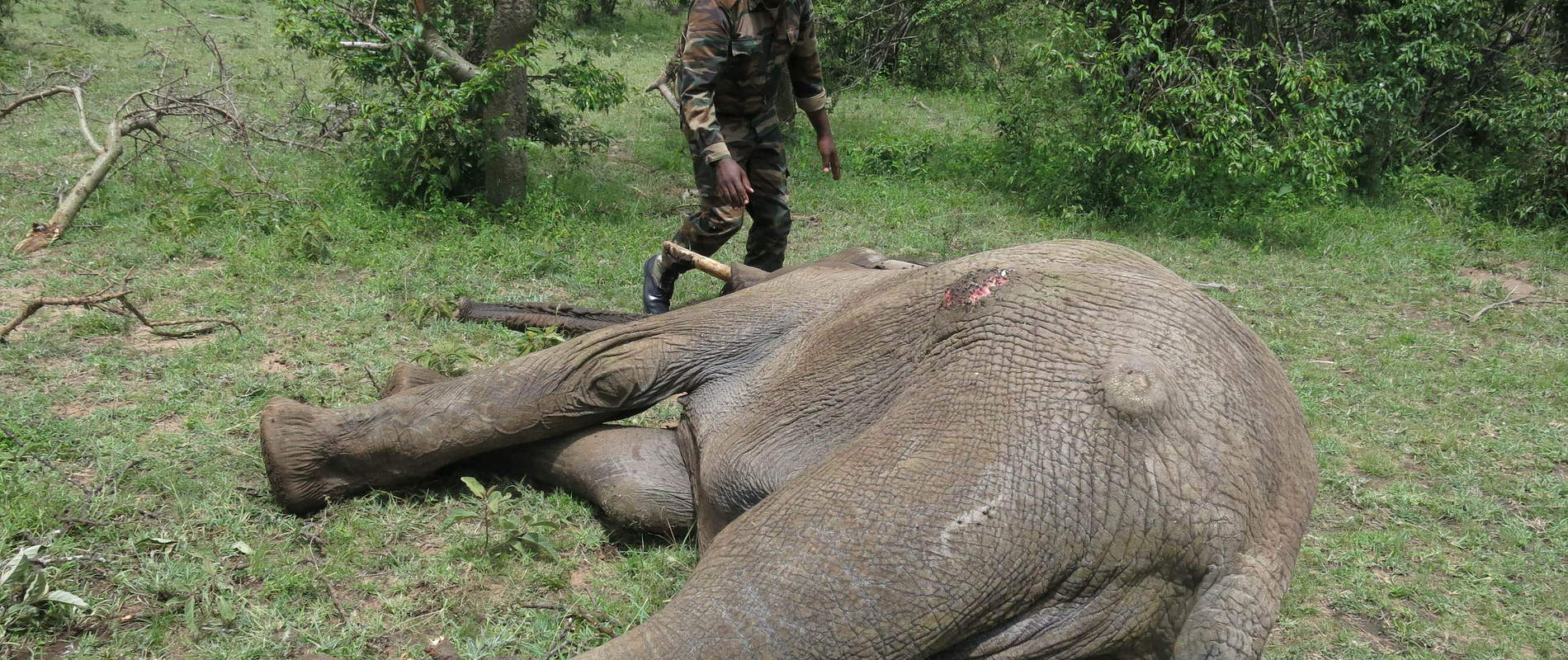FIELD VETERINARY REPORT FROM MASAI MARA – APRIL 2018 By Dr
FIELD VETERINARY REPORT FROM MASAI MARA – APRIL 2018
By Dr. Campaign Limo
Introduction
The period under review was characterised by increased precipitation with flooding recorded in most areas within the conservation area. Most luggas and seasonal rivers were flooded with many of them impassable. This made movement difficult. Cases reported and attended to decreased drastically.
The following cases were handled during the period;
CASE#1 RE-TREATMENT OF AN INJURED ELEPHANT
Date: 12-04-2018
Species: African elephant
Age: Sub-adult
Sex: Male
Location: Olarro conservancy
History
This young bull had been treated twice before after sustaining spear injuries to his right front leg and the right hip. He has been walking with a limp on his front right leg but this time round appeared somehow aggravated. Olarro conservancy management called the unit for examination. The Unit found this young male alone browsing near a watering point. His body condition appeared good though he had difficulty walking with the front right limb swollen. A decision was reached to immobilize him for review.
Immobilization, examination and treatment
He was restrained chemically by use of 12mgs Etorphine hydrochloride delivered through a 1.5ml dan-inject dart.Darting was done from foot given this elephant was in a thicket. It took eight minutes for the drugs to take full effect with the elephant assuming right lateral recumbency. He had to be turned over to facilitate easier examination of the affected limbs.


The right hip had already healed with scar tissue forming well. The front right elbow joint and downwards appeared swollen. The spear wound had since healed but the swelling appeared on the inner side of the limb and slightly lower than the joint. The swelling was pitting on application of pressure and yielded straw coloured fluid on aspiration. This depicted a fresh inflammatory reaction unrelated to the original injury by spear and was thought he could have sprained the same limb.
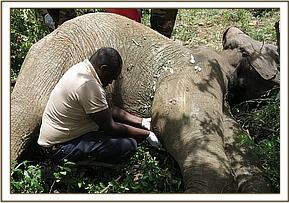

He was given Clindamycin antibiotics and 5000mgs Flunixin meglumine anti-inflammatory parenterally. The swollen part of the leg was massaged for ten minutes to improve circulation and reduce pain.
Reversal and Prognosis
Reversal was achieved by intravenous administration of 30mgs Diprenorphine hydrochloride given through a prominent ear vein. He woke up within four minutes and moved deeper into the thicket.
Prognosis for recovery is good.

CASE#2 ELEPHANT BULL TREATMENT
Date: 15th April 2018
Species: African elephant
Age: Adult
Sex: Male
Location: Olarro Conservancy
History
This big bull in company of other four big males was seen with a discharging wound on his left abdomen by Olarro management. They called the veterinary unit for intervention. These bulls had gone up a bushy hill on arrival and with bad weather due to heavy rains it became very difficult to access their position. Helicopter services were sought and he was spotted up in the hill in company of the other bulls, feeding well despite the obvious injury.
Immobilization, examination and treatment
He was pushed down the hill to a relatively open area before being darted from the air with 17mgs of Etorphine in a 3ml dan-inject dart and he took ten minutes before assuming sternal recumbency between two big trees. Working space was limited and it became hard to push him over to lie on his laterals hence the team had to work on him while in this uncomfortable position but quickly to avoid complications. However careful monitoring was done when being treated. The wound was caused by spearing approximately 48 hours before intervention. No foreign body was detected but fragments of rib cartilage were retrieved. The damage to the rib cartilages were caused by the spear. Luckily that was as far as the spear could reach as no damage to the peritoneal and pleural wall was evident. None of the chambers were accessed by the spear as their walls remained intact.
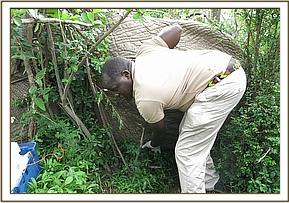

The wound was debrided with Hydrogen peroxide and all necrotic tissues removed before being rinsed with clean water and thereafter tincture of iodine disinfectant applied. Green clay was finally applied to hasten healing. Other treatments include parenteral administration of 30000mgs Amoxicillin antibiotic and 5000mgs Flunixin meglumine anti-inflammatory.
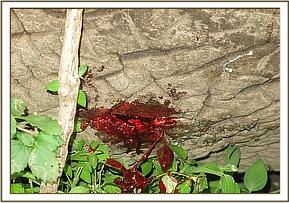

Reversal and Prognosis
Reversal was achieved by administration of 42mgs Diprenorphine hydrochloride given intravenously through a prominent ear vein. This bull elephant is expected to recover fully.

CASE#3 TREATMENT OF AN INJURED ELEPHANT
Date: 21st April 2018
Species: African elephant
Sex: Male
Age: Young adult
Location: Olarro conservancy
History
This young bull was spotted in Olarro conservancy by their rangers with injuries on his left flank and left thigh. He was in a herd of hundreds of elephants currently staying within Olarro conservancy. He was elusive as he went up the hill soon after being spotted. A helicopter had to be used to access and assess the bull, and then used to push him down the hill to an open area.


Immobilization, examination and treatment
Restraint was achieved chemically by use of 15mgs Etorphine delivered through a 1.5ml dan-inject dart. He was darted from the air as he approached the plains from the hill. The drugs took effect after ten minutes with the bull assuming right lateral recumbency exposing the injuries. The more caudal injury had healed with significant fibrosis. Scanning with a metal detector was negative for any foreign metallic object. Oxytetracycline spray was applied topically.
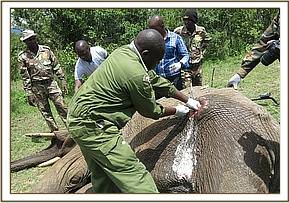

The injury to the left flank was a big abscess with scanty purulent discharge. This was lanced open and the entire abscess evacuated. Probing revealed an arrowhead deep seated inside the abscess. After removing the arrow and completely draining the abscess, Hydrogen peroxide was applied to debride and remove any remaining necrotic tissue. Tincture of iodine was used for disinfection before green clay was packed into the wound.
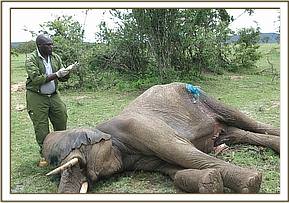

Additional treatments for this elephant include parenteral administration of 30000mgs Amoxicillin antibiotic and 5000mgs Flunixin meglumine anti-inflammatory.
Reversal and Prognosis
Reversal of the anaesthetic was achieved by use of 42mgs Diprenorphine hydrochloride delivered intravenously through a prominent ear vein.
Prognosis for recovery is good.
CASE#4 EXAMINATION OF A DEAD ELEPHANT
Date: 22nd April 2018
Species: African elephant
Sex: Male
Age: Approximately 15 years
Location: Masai Mara National Reserve near Talek
History
This elephant carcass was seen and reported to us by Mara Lion Research Field Officers and the Mara National Reserve Management were informed of the incident.
Examination
The carcass revealed some degree of emaciation with bony prominences easily discernible. The carcass was relatively fresh, less than 24hours old but hyenas and vultures had greatly scavenged it, leaving parts of skin and bones only. The tusks were intact and were retrieved by the Reserve rangers for accountability and custody.

Due to its state, cause of death could not easily be ascertained but it is thought to have had a chronic problem.
CASE#5 INJURED GIRAFFE
Date 22nd April 2018
Species: Masai giraffe
Sex: Male
Age: Adult
Location: Kawaii
History
This mature bull was seen limping with an injury on the caudal aspect of his left hind leg by Mara Triangle Rangers and Community Scouts around this area on their patrol. They called the veterinary unit for help. The Vet Unit located the bull browsing with a big herd in a small bush of acacia. He walked with difficulty from the injury.
Immobilization, examination and treatment
Restraint was achieved by use of a combination of 12mgs Etorphine hydrochloride and 50mgs Azaperone delivered through a 3ml dan-inject dart from a vehicle. It took ten minutes for the drugs to take full effect and the giraffe was roped and brought down for effective restraint.
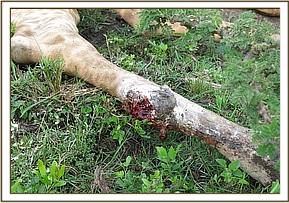

Examination revealed an injury caused by a sharp object to the distal caudal aspect of his left hindleg. The wound was infested with maggots. It was debrided and all maggots removed manually. After rinsing the wound clean, tincture of Iodine was used for disinfection before Oxytetracycline wound spray was applied.


Other treatments were intramuscular administration of 7500mgs amoxicillin antibiotic and 1500mgs flunixin meglumine anti-inflammatory. He also received 200mgs ivermectin parasiticide to counter any parasite infestation.
Reversal and Prognosis
Reversal was achieved by administration of 36mgs Diprenorphine hydrochloride given intravenously through the jugular vein. He woke up with little support after three minutes and moved away.
Prognosis for recovery is good.
Conclusion
The Mara Mobile Veterinary unit appreciates help offered to it by various stakeholders in the conservation industry, many of whom reported and helped in handling of the cases.
Many thanks to Minara Foundation through The DSWT for their continued support and their partnership with KWS that has seen many animals saved.
